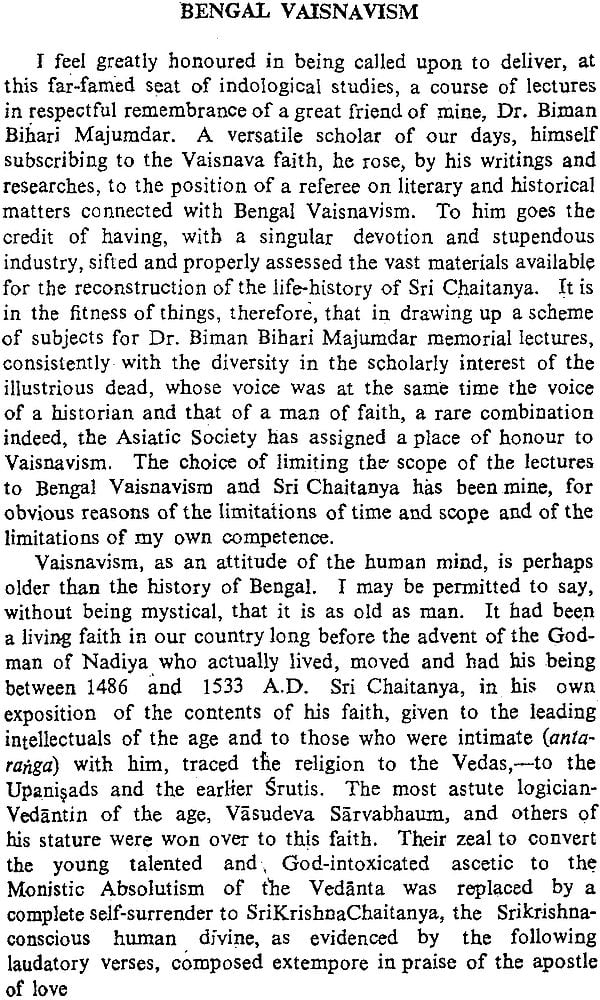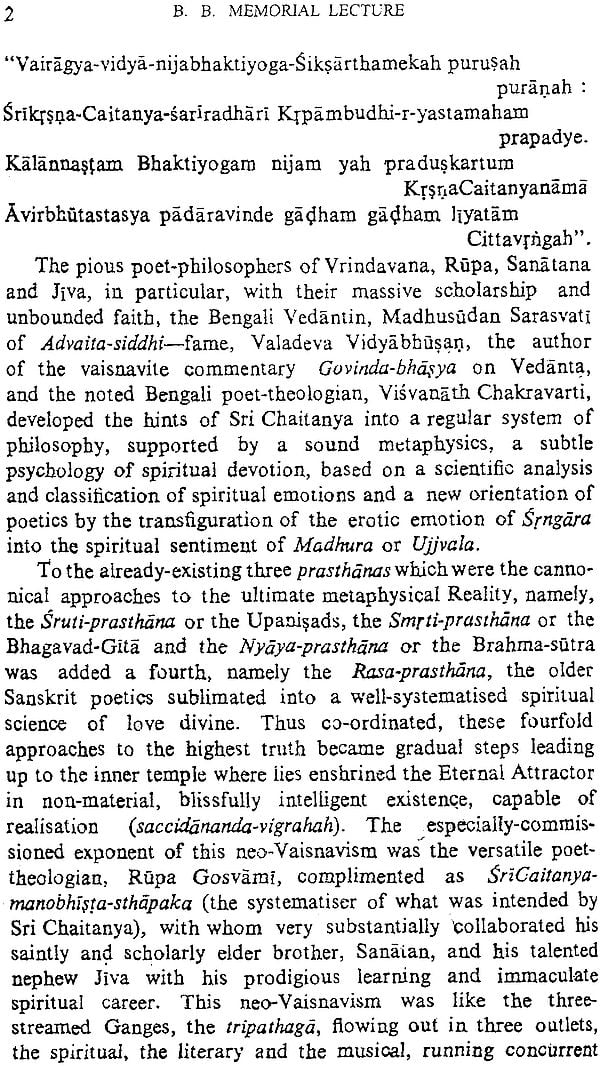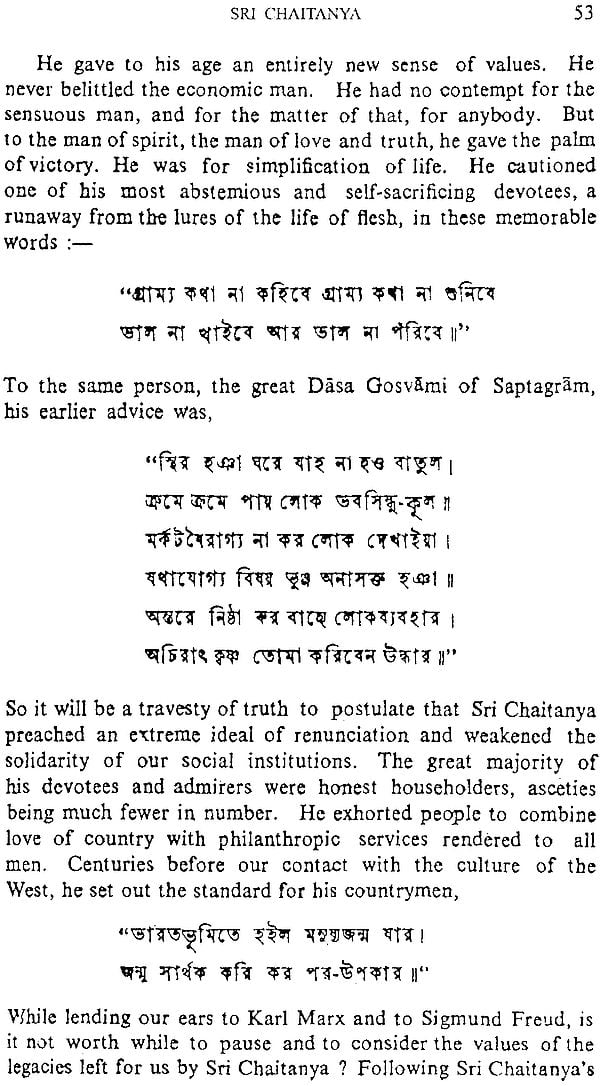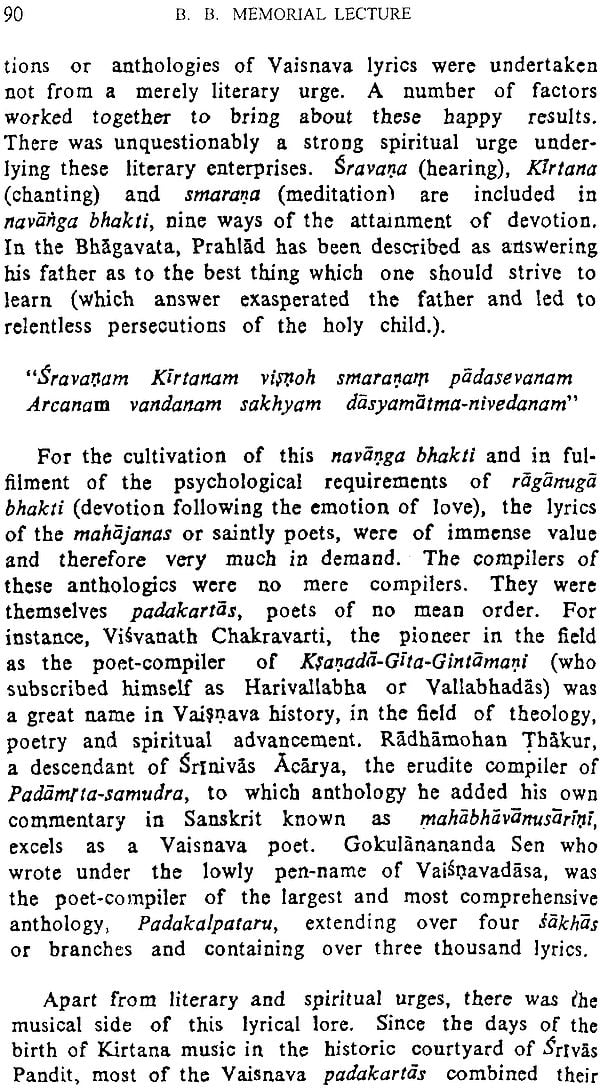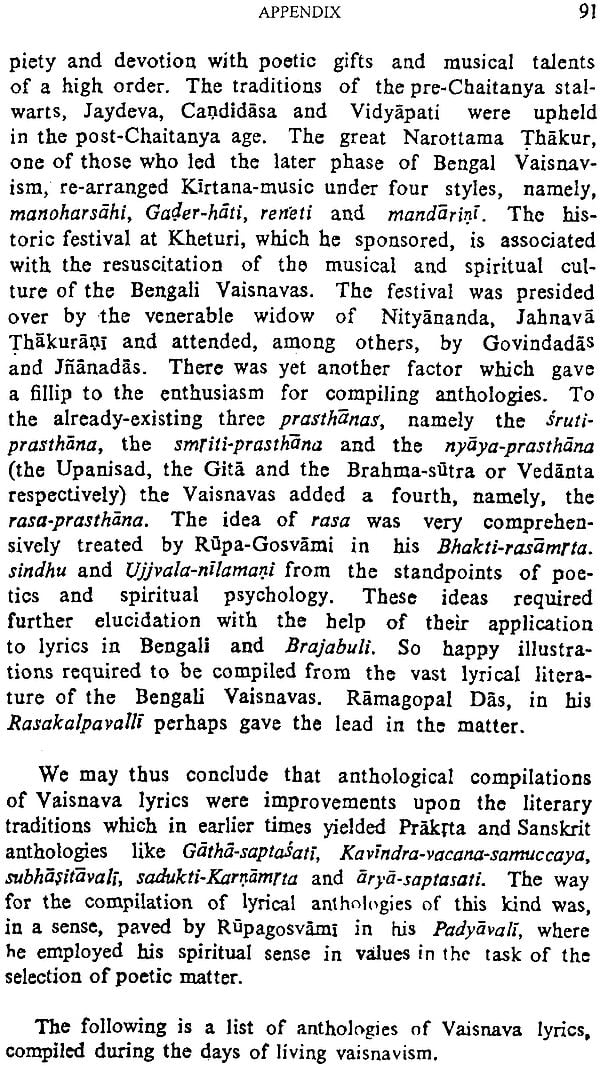
Bengal Vaisnavism and Sri Chaitanya
Book Specification
| Item Code: | IDH462 |
| Author: | Janardan Chakravarti |
| Publisher: | The Asiatic Society |
| Language: | English |
| Edition: | 2016 |
| ISBN: | 9789381574355 |
| Pages: | 103 |
| Cover: | Paperback |
| Other Details | 8.1" X 5.2 |
| Weight | 140 gm |
Book Description
Foreword
It is a great pleasure that I am presenting to the world of scholars the first reprint of the monograph Bengal Vaisnavism and Sri Chaitanya of Prof. Janardan Chakravarti, a well-known scholar in the field. This was published in the year 1975 even though this lecture was delivered on 25 and 29 January 1973 by Prof. Chakravarti as Dr. Biman Behari Majumdar lecture.
It is well-known that researches on Vaisnavism in Bengal and its connected literature to a large extent were initiated under the direct patronage of the Asiatic Society almost since the beginning of the Society. In 1972 Sir William Jones, the founder President of the Society, translated Jayadeva's Gita Govinda and in 1854 Rajendralal Mitra edited Karnapura's Chaitanya Chandrodaya.
Prof. Chakravarti's work on the subject was well received by the scholars as is apparent from the fact that the Society is receiving requests from the scholars for reprinting the book once again.
I am happy to present the present publication in response to the persistent demand from the scholars. I hope this will be well appreciated by the scholars.
With a solemn sadness preying upon our thoughts of the moment, we proceed to play our humble role by prefacing our lectures on Bengal Vaisnavism and Sri Chaitanya with a few words in loving remembrance of our personal contact with the man behind the scholar which was Dr. Biman Behari Majumdar. The radiant life which we are called upon to memo- rialise with some of our stray thoughts recorded, on a subject which claimed the absorbing attention of the versatile scholar, was cut off, all on a sudden, before it unfolded its full span of possibilities.
Dr. Biman Behari Majumdar and myself happened to be contemporaries. He was my senior by two years. He just touched the last century like a geometrical tangent, by a year, while my pilgrimage to this planet began when the present century was in, by a year, In his pilgrimage to the far beyond, he marched ahead, leaving us behind. His life has been a com- mentary upon the poet's finding, "In short measures life may perfect be". His intellect, his life of spirit energised Ceaselessly and arduously. The search-light of the savant's inner vision illumined the dark corners of a plurality of cultural subjects covering history, economics, political philosophy, Vaisnavism and its vast and varied literature, and so on and so forth.
Our academic career ran almost concurrently. We matri- eulated together in 1917, a memorable year, when the whole human population of the world was hedged in by the great conflagration of the First World War. But the academic year 1917 of our little part of the globe was memorable not on that account. The why and how of its unforgettable character may be historically missed by the younger generations but not by the gentlemen some of whom it will not be inappropriate in this connection to remember as persons who wore the shoo that pinched.
Dr. Syama Prasad Mukherji who best answers the description of the Bible that God takes away, early in life, those whom He loves was one of those who belonged to the team of the year's matriculates. Manoranjan Chatterji of Dacca, the most brilliant of those who matriculated that year, judged by the examination results, did not live to fulfil the promises of life which began with a phenomenal success.
Principal Ramani Ranjan Ray who later distinguished himself by the teaching of science and as an educational administrator and who did not unfortunately live to a good old age was a member of the team. Dr. Sarvanisahay Guha Sarkar who similarly distinguished himself in science teaching at the Uni- versity level was another member of the group which had to pass through the ordeal of having to sit thrice for the first public examination owing to leakage of questions. Sri Braja Kanta Guha and Sri Subodh Ranjan Das Gupta, distinguished members of the topmost judiciary of the country, the former having switched over to University administration as a Vice- Chancellor, had to cross the same hurdle. Late Govinda Prasad Palit and Late Dr. Matilal Das, worthy members of .the provincial judiciary shared the same fate. My dear friend, Matilal, also, was, in reality, a man of letters, an idealist and dreamer, a preacher of the glories of ancient India. Sri Chapala Kanta Bhattacharya, a doyen in Indian Journalism and a legis- lator and member of the Calcutta University, had to pass through the same harrowing experiences. Dr. Joges Chandra Banerji who elbowed his way to the forefront of the medical profession, Dr. Amiya Kumar Bose, a top-ranking member of the same profession and Dr. Joges Chandra Bose, a gifted physician with insight were sailors in the same boat. Prof. Sukumar Sen of the Calcutta University, not to know whom 'argues oneself unknown', Professor Susobhan Sarkar, reputed' Professor of History in Presidency College and several Univer- sities and Professor Biman Bihari Majumdar, the two last- named forming the talented twin occupying the two top positions in Class I in M.A. History in their year were also matriculates of the memorable year, for the present closing the formidable list. My humble presence on the list and my friendship with the members of the team, just named, which began early or late in life, have been a matter of great pride and profit to me.
I have named a few academic notables among Dr. Majumdar's, contemporaries just to give an idea of the times and the beginnings of his extraordinary career as a scholar which was crowned with a First Class in M.A. History of the University of Calcutta. By the bye, I was told by Maharajkumar Somendra Chandra Nandy of Cossimbazar, who very kindly attended my Dr. Biman Behari Mazumdar memorial lectures in the Asiatic Society that Dr. Majumdar had brought honour for the Berhampur Krishnath College, being the very first to gradu- ate with First Class Honours in .History from the institution. Having completed his regular academic career in i923, Biman Behari did his noviciate, for a short while, in historical researches, under the great orientalist, Pracyavidyamaharnava Nagendranath Basu of Viswakosh fame. For private reasons I had to stay off from my M.A. examination in 1923. when it fell due. Professor Dines Chandra Sen, my guru, wanted me to live with him at 7, Viswakosh Lane, Baghbazar, and to work as his assistant in connection with the editing and tralslating of the Eastern Bengal Ballads. The bouse next to my Gurukul belonged to the Pracyavidya-maharnava, a great friend of Dr. Dines Chandra Sen, the two friends having built houses contiguously at the Kantapukur. area in Baghbazar. It was at this period of my life that Biman Behari and myself were drawn close to each other. Biman Behari had then an idea of doubling his qualifications by taking his M.A. Degree in Indian Vernaculars, as the subject was then called. He came to me every now and then and we had the most fruitful discus- sions on literature and literary history. He changed the project, however, choosing, instead, Economics as his subject for the 2nd Master's Degree. Academic distinctions in the ken of the scholar's ambition followed one after another. He was awarded the Premchand Raychand Scholarship on his thesis, A History of Political Thought from Rammohun to Dayananda. He was a recipient of the Mouat Medal and the Griffith Memorial Prize in two successive years.
| Foreword | v |
| Foreword To The First Edition | vii |
| Preface | ix |
| Lecture I | |
| Bengal Vaisnavism | 1 |
| Lecture II | |
| Sri Chaitanya | 29 |
| Appendix | 55 |
